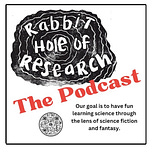In this Episode Georgia and Joe talk about Gaba’s Girl, the strange history and science of reanimation, and trying to remember the plot of 80’s movies. Have Fun!
Welcome to Episode 1 Show Notes:
This is a collection of stuff that we didn’t get to in the show or talked about in the show briefly. We try to include links when possible and connecting our research paths. Maybe in future we will have a better organization system, but for now enjoy the Rabbit Hole of Show Notes!
Let us know:
What do you think about Gaba and the history of reanimation?
Any questions we didn’t cover?
What did we get wrong (read the show note first)?
The Show Notes:
Lester Gaba:
Lester the first mannequin influencer
Some Terms:
Robotsexuality-term for falling in love with robot.
Lovotics refers to the research of human-to-robot relationship. (Lando and L3-37)
Books/Movies reanimation rabbit hole:
Mannequin-Kim Cattrall
Frankenstein- 1818
Weird Science
Real life reanimation experimenters :
Luigi Galvani-1780
First to show that electrical signals could move freshly dissected frog legs.
During a dissection a metal look touched the muscle and the frog twitches like it would hop away. Galvani said this was caused by a special muscle viral fluid—animal electricity.
Alessandro Volta (credited with inventing the battery and field of electrochemistry), 1782, disagreed and said any electricity could produce a similar effect. And Volta started testing this on all sorts of dead things.
Giovanni Aldini
Galvani was at the end of his career, so his nephew took up the charge against Volta. After the hanging of a man named George Foster (drowned his wife and kid in a canal), the body went to the lab of Giovanni.
During a demonstration he soaped and salted the man’s ears and connected him to electrodes. As he passed a current through the man his face and mouth started to twitch.
A reporter noted, “ On the first application of the process to the face, the jaws of the deceased criminal began to quiver, and the adjoining muscles were horribly contorted, and one eye was actually opened. In the subsequent part of the process the right hand was raised and clenched, and the legs and thighs were set in motion.”
It was decided by the government that if George did come back to life he should be hung again.
Andrew Ure
Experimented on hanged convicts—up to 300
He would draw a crowd and shock different body part to make them twitch and please the crowd. Not really answering any scientific questions.
“Every muscle of the body was immediately agitated with convulsive movements resembling a violent shuddering from cold. . . On moving the second rod from hip to heel, the knee being previously bent, the leg was thrown out with such violence as nearly to overturn one of the assistants, who in vain tried to prevent its extension. The body was also made to perform the movements of breathing by stimulating the phrenic nerve and the diaphragm.”
“When the supraorbital nerve was excited ‘every muscle in his countenance was simultaneously thrown into fearful action; rage, horror, despair, anguish, and ghastly smiles, united their hideous expressions in the murderer’s face, surpassing far the wildest representations of Fuseli or a Kean. At this period several of the spectators were forced to leave the apartment from terror or sickness, and one gentleman fainted.”
Eventually things got boring and the church was threading to shut him down afraid that he was summoning devils.
In time, he gave up the reanimation efforts, correctly concluding it was a waste of his time, and then turned his attention to more productive pursuits, such as revolutionizing the way volumes are measured and with being the first to describe a bi-metallic thermostat.
Early 1920’s Russian experiments
Sergei Bryukhonenko was a scientist living in Russia during the Revolution who invented what he called an “autojektor,” or the heart-lung machine. These exist today, and Bryukhonenko’s design was fundamentally sound, but it’s the way he tested it that’s creepy.
During his early experiments, Bryukhonenko decapitated a dog and immediately connected it to his machine, which drew out blood from the veins and circulated it through a filter for oxygenation. According to his paper, Bryukhonenko kept the dog’s severed head alive and responsive for over an hour and a half, before blood clots built up and killed the dog on the table.
According to the Soviet Congress of Science, Bryukhonenko actually managed reanimating of a human in 1930.
Given the hours-dead corpse of a man who had committed suicide, the team plugged his body up to the autojektor and pushed a witches’ brew of odd chemicals into his bloodstream.
They opened his chest cavity, administered a mix of chemicals and got a steady rhythm. The man then started to groan and move, this freaked everyone out and they shut down the experiment letting the man did for good.
Today: Luigi Galvani initial work is the basis for Electrical muscle stimulation (EMS), also known as neuromuscular electrical stimulation (NMES) or electromyostimulation, is the elicitation of muscle contraction using electric impulses
SHOW ADVICE:
Please don’t try to reanimate things in your living room.
OTHER STUFF
galvanism — the idea that electricity could reanimate dead tissue
in honour of his pioneering work his name was given to the unit of electrical potential, the Volt.
In 1751, England passed the Murder Act, which allowed the bodies of executed murderers to be used for experimentation and scientific study. https://en.m.wikipedia.org/wiki/Murder\_Act\_1751
Andrew Ure was Scottish and performed his experiment on a hanged convict (Matthew Clydesdale) in 1818. After experiment did describe a device that would later be the basis for the defibrillator.
Mary Shelley was surrounded and influenced by science demonstrations (Galvani, Volta and Aldini were friends of Mary’s father), but some speculate that Mary Shelley used Ure as a model for her main character in the book, Frankenstein (1818).
Operating theater or operating room, is a facility where surgical procedures are performed . Historically, operating theaters where actually an amphitheater and a source of education and entertainment, often with “music and festive atmosphere…” https://daily.jstor.org/inside-the-operating-theater-surgery-as-spectacle/
Research on using electrodes to give amputees Restoring the sense of touch in amputees - Today's Medical Developments
More reanimating attempts not mentioned:
Another scientists in the field of reanimation i failed to mention was Robert E. Cornish, an American biologist who studied at the University of California Berkeley. Cornish who reportedly managed to revive two dogs by rocking them back and forth to move blood around while injecting the animals with a mixture of anticoagulants and steroids. When Cornish announced he was ready to perform his experiment on humans, a California death-row inmate, Thomas McMonigle, volunteered his body post-execution, but the State of California denied his request.
Zvonimir Vrseljal et al, April 2019 Nature. Revive pig brain 4-hours post-mortem
Organ X maintains life and raises questions about what it means to be dead.
Other Rabbit Holes:
And you may be wondering about cryonics (I wrote a newsletter about this Hey baby it’s cold outside. Let’s stay in and talk Cryonics!), and we still have no idea how to revive a frozen body, but research is ongoing.
You can always email (I do answer back), click the comment link below, or follow me online for real time tracking.
















Share this post